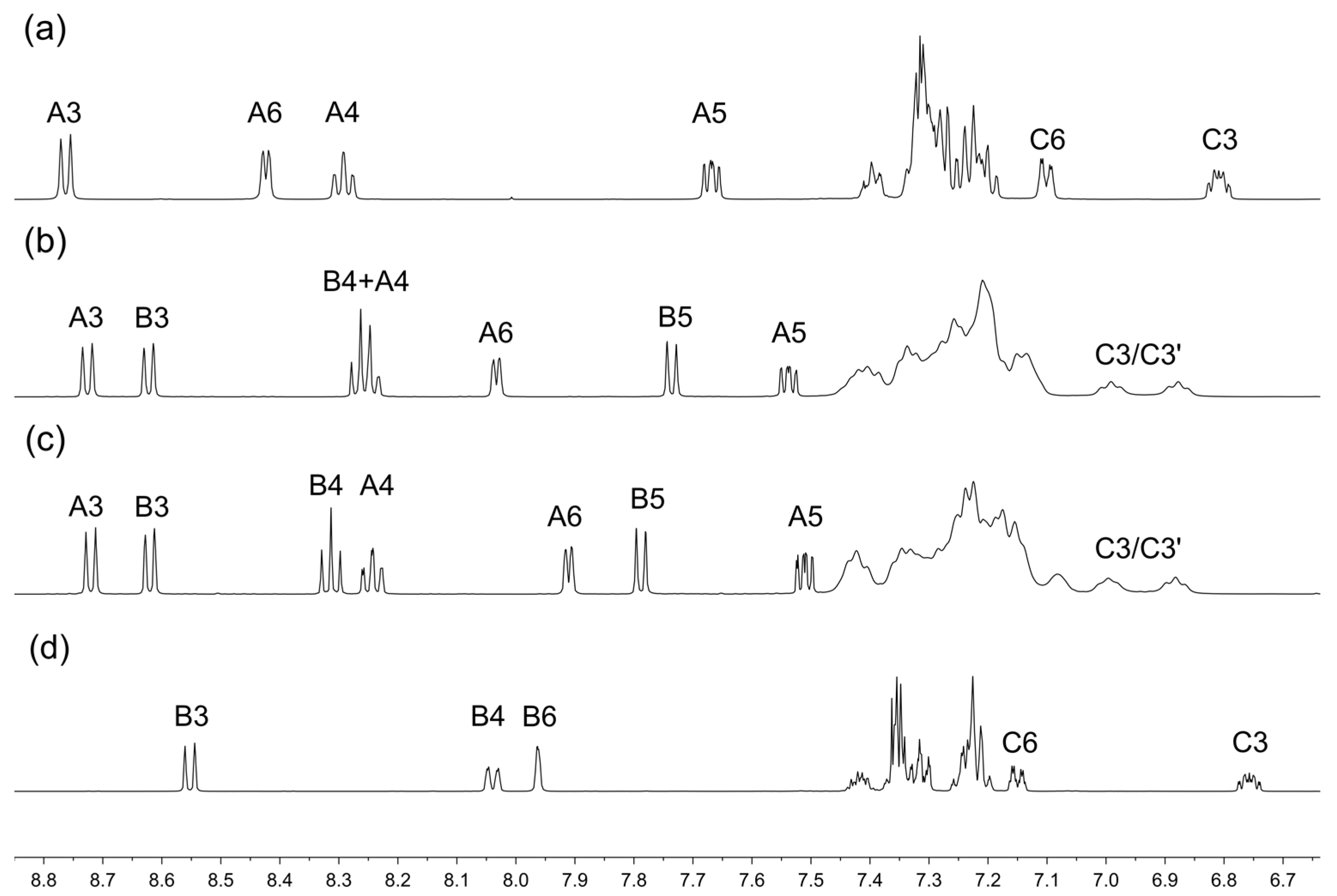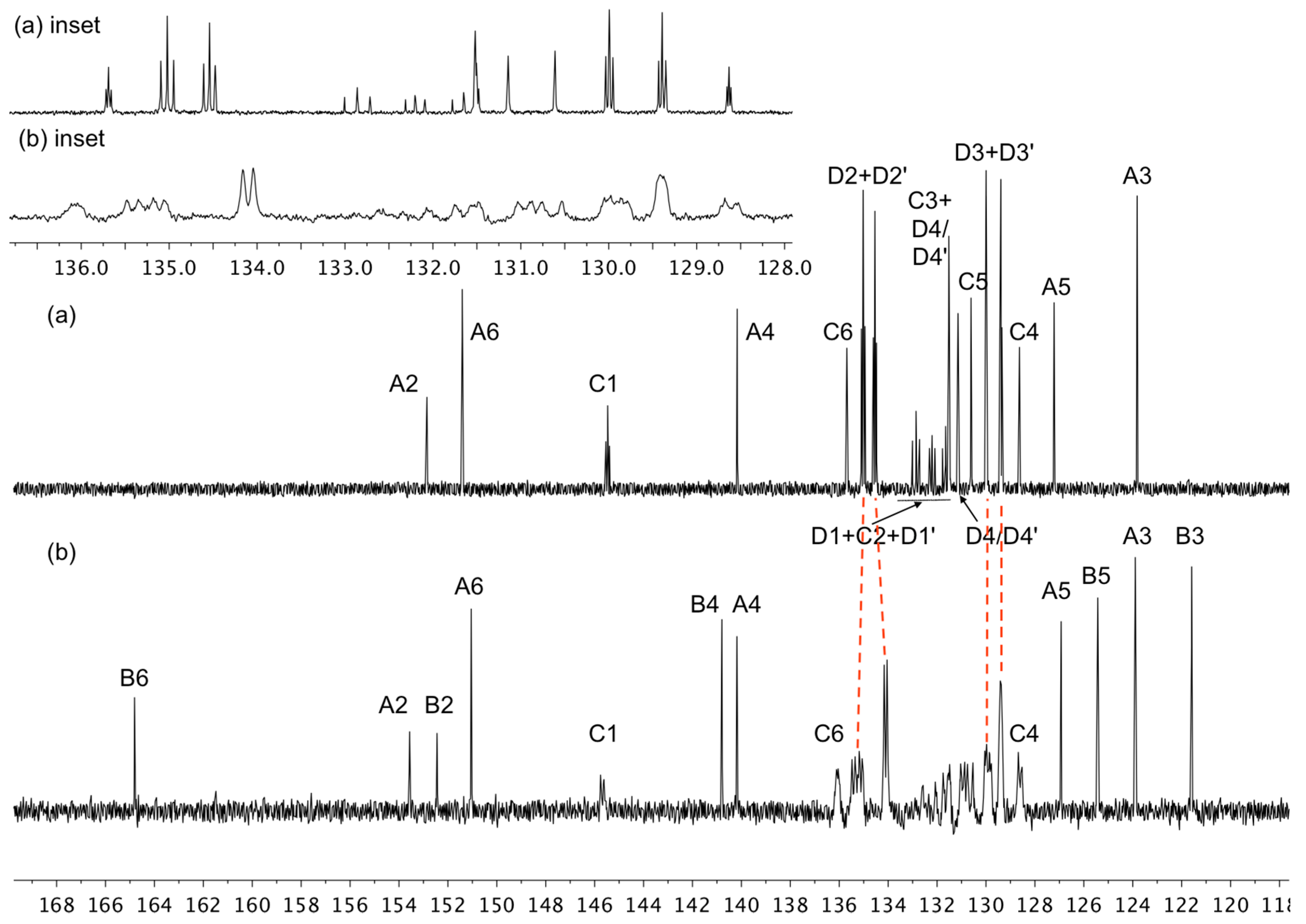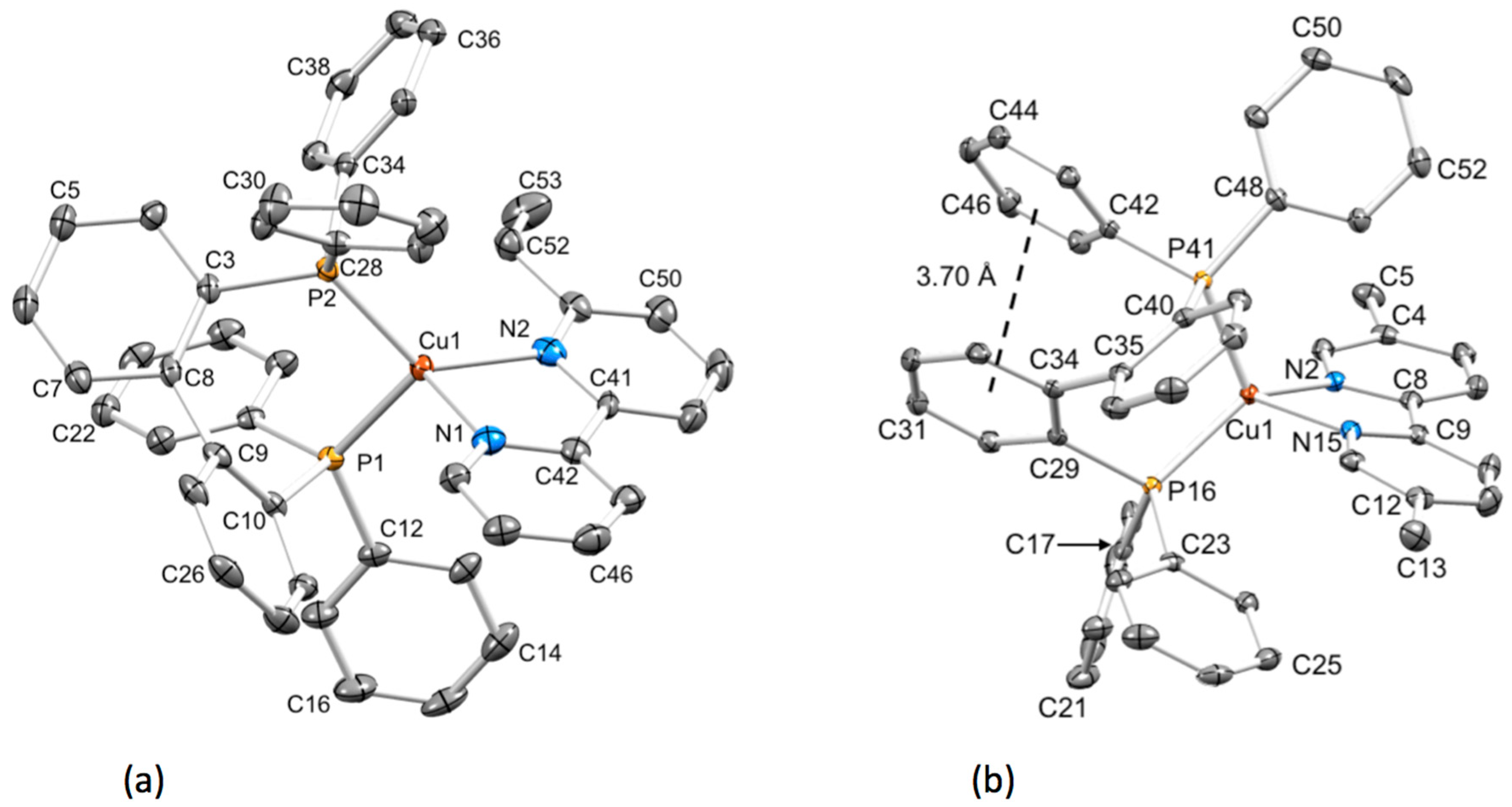Hinged and Wide: A New P^P Ligand for Emissive [Cu(P^P)(N^N)][PF6] Complexes
Abstract
:1. Introduction
2. Results and Discussion
2.1. Synthesis and Characterization of [Cu(BIPHEP)(N^N][PF6] Complexes
2.2. Single Crystal X-ray Diffraction
2.3. Electrochemical Behaviour
2.4. Photophysical Properties
3. Materials and Methods
3.1. General
3.2. [Cu(BIPHEP)(bpy)][PF6]
3.3. [Cu(BIPHEP)(6-Mebpy)][PF6]
3.4. [Cu(BIPHEP)(6-Etbpy)][PF6]
3.5. [Cu(BIPHEP)(5,5′-Me2bpy)][PF6]
3.6. Crystallography
3.7. [Cu(BIPHEP)(bpy)][PF6]∙CH2Cl2
3.8. [Cu(BIPHEP)(6-Mebpy)][PF6]∙Et2O∙0.5H2O
3.9. [Cu(BIPHEP)(6-Etbpy)][PF6]
3.10. [Cu(BIPHEP)(5,5′-Me2bpy)][PF6]∙CH2Cl2
4. Conclusions
Supplementary Materials
Author Contributions
Funding
Acknowledgments
Conflicts of Interest
References
- Bizzarri, C.; Spuling, E.; Knoll, D.M.; Volz, D.; Bräse, S. Sustainable metal complexes for organic light-emitting diodes (OLEDs). Coord. Chem. Rev. 2018, 373, 49–82. [Google Scholar] [CrossRef]
- Volz, D.; Wallesch, M.; Fléchon, C.; Danz, M.; Verma, A.; Navarro, J.M.; Zink, D.M.; Bräse, S.; Baumann, T. From iridium and platinum to copper and carbon: new avenues for more sustainability in organic light-emitting diodes. Green Chem. 2015, 17, 1988–2011. [Google Scholar] [CrossRef]
- Fresta, E.; Costa, R.D. Beyond traditional light-emitting electrochemical cells—A review of new device designs and emitters. J. Mater. Chem. C 2017, 5, 5643–5675. [Google Scholar] [CrossRef]
- Elie, M.; Gaillard, S.; Renaud, J.L. Light-Emitting Electrochemical Cells: Concepts, Advances and Challenges; Costa, R.D., Ed.; Springer International Publishing: New York, NY, USA, 2017. [Google Scholar] [CrossRef]
- Salehi, A.; Fu, X.; Shin, D.-H.; So, F. Recent Advances in OLED Optical Design. Adv. Funct. Mater. 2019, 29, 1808803. [Google Scholar] [CrossRef]
- Luo, D.; Chen, Q.; Liu, B.; Qiu, Y. Emergence of Flexible White Organic Light-Emitting Diodes. Polymers 2019, 11, 384. [Google Scholar] [CrossRef]
- Wong, M.Y.; Zysman-Colman, E. Purely Organic Thermally Activated Delayed Fluorescence Materials for Organic Light-Emitting Diodes. Adv. Mater. 2017, 29, 1605444. [Google Scholar] [CrossRef]
- Yerson, H. (Ed.) Highly Eficient OLEDs: Materials Based on Thermally Activated Delayed Fluorescence; John Wiley & Sons: Weinheim, Germany, 2019; ISBN 978-3-527-33900-6. [Google Scholar]
- Czerwieniec, R.; Leitl, M.J.; Homeier, H.H.H.; Yerson, H. Cu(I) complexes—Thermally activated delayed fluorescence. Photophysical approach and material design. Coord. Chem. Rev. 2016, 325, 2–28. [Google Scholar] [CrossRef]
- Bergmann, L.; Zink, D.M.; Bauman, T.; Volz, D.; Bräse, S. Metal-Oragnic and Organic TADF Materials: Status, Challenges and Characterization. Top. Curr. Chem. 2016, 374, 22. [Google Scholar] [CrossRef]
- Yang, Z.; Mao, Z.; Xie, Z.; Zhang, Y.; Liu, S.; Zhao, J.; Xu, J.; Chi, Z.; Aldred, M.P. Recent Advances in Organic Thermally Activated Delayed Fluorescence Materials. Chem. Soc. Rev. 2017, 46, 915–1016. [Google Scholar] [CrossRef]
- Buckner, M.T.; McMillin, D.R. Photoluminescence from copper(I) complexes with low-lying metal-to-ligand charge transfer excited states. J. Chem. Soc. Chem. Commun. 1978, 759–761. [Google Scholar] [CrossRef]
- Rader, R.A.; McMillin, D.R.; Buckner, M.T.; Matthews, T.G.; Casadonte, D.J.; Lengel, R.K.; Whittaker, S.B.; Darmon, L.M.; Lytle, F.E. Photostudies of 2,2′-bipyridine bis(triphenylphosphine)copper(1+), 1,10-phenanthroline bis(triphenylphosphine)copper(1+), and 2,9-dimethyl-1,10-phenanthroline bis(triphenylphosphine)copper(1+) in solution and in rigid, low-temperature glasses. Simultaneous multiple emissions from intraligand and charge-transfer states. J. Am. Chem. Soc. 1981, 103, 5906–5912. [Google Scholar] [CrossRef]
- Kramer, P.C.J.; Van Leeuwen, P.W.N.M.; Reek, J.N.H. Wide Bite Angle Diphosphines: Xantphos Ligands in Transition Metal Complexes and Catalysis. Acc. Chem. Rev. 2001, 34, 895–904. [Google Scholar] [CrossRef]
- Costa, R.D.; Tordera, D.; Ortí, E.; Bolink, H.J.; Schönle, J.; Graber, S.; Housecroft, C.E.; Constable, E.C.; Zampese, J.A. Copper(I) complexes for sustainable light-emitting electrochemical cells. J. Mater. Chem. C 2011, 21, 16108–16118. [Google Scholar] [CrossRef]
- Yang, L.; Feng, J.-K.; Ren, A.-M.; Zhang, M.; Ma, Y.-G.; Liu, X.-D. Structures, Electronic States and Electroluminescent Properties of a Series of CuI Complexes. Eur. J. Inorg. Chem. 2005, 2005, 1867–1879. [Google Scholar] [CrossRef]
- Keller, S.; Brunner, F.; Junquera-Hernández, J.M.; Pertegás, A.; La-Placa, M.-G.; Prescimone, A.; Constable, E.C.; Bolink, H.J.; Ortí, E.; Housecroft, C.E. CF3 Substitution of [Cu(P^P)(bpy)][PF6] complexes: Effects on Photophysical Properties and Light-emitting Electrochemical Cell Performance. ChemPlusChem 2018, 83, 217–229. [Google Scholar] [CrossRef]
- Keller, S.; Constable, E.C.; Housecroft, C.E.; Neuburger, M.; Prescimone, A.; Longo, G.; Pertegás, A.; Sessolo, M.; Bolink, H.J. [Cu(bpy)(P^P)]+ containing light-emitting electrochemical cells: improving performance through simple substitution. Dalton Trans. 2014, 43, 16593–16596. [Google Scholar] [CrossRef]
- Keller, S.; Pertegás, A.; Longo, G.; Martínez, L.; Cerdá, J.; Junquera-Hernández, J.M.; Prescimone, A.; Constable, E.C.; Housecroft, C.E.; Ortí, E.; et al. Shine bright or live long: substituent effects in [Cu(N^N)(P^P)]+-based light-emitting electrochemical cells where N^N is a 6-substituted 2,2′-bipyridine. J. Mater. Chem. C 2016, 4, 3857–3871. [Google Scholar] [CrossRef]
- Fresta, E.; Volpi, G.; Milanesio, M.; Garino, C.; Barolo, C.; Costa, R.D. Novel Ligand and Device Designs for Stable Light-Emitting Electrochemical Cells Based on Heteroleptic Copper(I) Complexes. Inorg. Chem. 2018, 57, 10469–10479. [Google Scholar] [CrossRef]
- Brunner, F.; Martínez-Sarti, L.; Keller, S.; Pertegás, A.; Prescimone, A.; Constable, E.C.; Bolink, H.J.; Housecroft, C.E. Peripheral halo-functionalization in [Cu(N^N)(P^P)]+ emitters: influence on the performances of light-emitting electrochemical cells. Dalton Trans. 2016, 45, 15180–15192. [Google Scholar] [CrossRef]
- Alkan-Zambada, M.; Keller, S.; Martínez-Sarti, L.; Prescimone, A.; Junquera-Hernández, J.M.; Constable, E.C.; Bolink, H.J.; Sessolo, M.; Ortí, E.; Housecroft, C.E. [Cu(P^P)(N^N)][PF6] compounds with bis(phosphane) and 6-alkoxy, 6-alkylthio, 6-phenyloxy and 6-phenylthio-substituted 2,2′-bipyridine ligands for light-emitting electrochemical cells. J. Mater. Chem. C 2018, 6, 8460–8471. [Google Scholar] [CrossRef]
- Keller, S.; Prescimone, A.; Bolink, H.J.; Sessolo, M.; Longo, G.; Martínez-Sarti, L.; Junquera-Hernández, J.-M.; Constable, E.C.; Ortí, E.; Housecroft, C.E. Luminescent copper(I) complexes with bisphosphane and halogen-substituted 2,2′-bipyridine ligands. Dalton Trans. 2018, 47, 14263–14276. [Google Scholar] [CrossRef] [PubMed]
- Brunner, F.; Babaei, A.; Pertegás, A.; Junquera-Hernández, J.M.; Prescimone, A.; Constable, E.C.; Bolink, H.J.; Sessolo, M.; Ortí, E.; Housecroft, C.E. Phosphane tuning in heteroleptic [Cu(N^N)(P^P)]+ complexes for light-emitting electrochemical cells. Dalton Trans. 2019, 48, 446–460. [Google Scholar] [CrossRef] [PubMed]
- Keller, S.; Prescimone, A.; Constable, E.C.; Housecroft, C.E. Copper(I) and silver(I) complexes of 9,9-dimethyl-4,5-bis(di-tert-butylphosphino)xanthene: photophysical properties and structural rigidity under pressure. Photochem. Photobiol Sci. 2018, 17, 375–385. [Google Scholar] [CrossRef] [PubMed]
- Groom, C.R.; Bruno, I.J.; Lightfoot, M.P.; Ward, S.C. The Cambridge Structural Database. Acta Cryst. 2016, B72, 171–179. [Google Scholar] [CrossRef]
- Shi, Y.; Liu, X.; Shan, Y.; Zhang, X.; Kong, W.; Lu, Y.; Tan, Z.; Li, X.-L. Naked-eye repeatable off–on–off and on–off–on switching luminescence of copper(I)-1H-imidazo[4,5-f][1,10]phenanthroline complexes with reversible acid–base responses. Dalton Trans. 2019, 48, 2430–2441. [Google Scholar] [CrossRef]
- Saito, K.; Tsukuda, T.; Tsubomura, T. Synthesis and Luminescence of New Cu(I) Complexes Containing a Binap Ligand and a Diimine Ligand. Bull. Chem. Soc. Jpn. 2006, 79, 437–441. [Google Scholar] [CrossRef]
- Feng, X.-Y.; Xin, X.-L.; Guo, Y.-M.; Chen, L.-L.; Liang, Y.-Y.; Xu, M.; Li, X.-L. Synthesis, structure and solid luminescence of copper(I)–bromodiimine–diphosphine complexes. Polyhedron 2015, 101, 23–28. [Google Scholar] [CrossRef]
- Tan, C.-H.; Ma, X.; Zhu, Q.-L.; Huang, Y.-H.; Fu, R.-B.; Hu, S.-M.; Sheng, T.-L.; Wu, X.-T. Syntheses, crystal structures and properties of dinuclear copper(I) complexes. J. Mol. Struct. 2012, 1007, 26–30. [Google Scholar] [CrossRef]
- Oczipka, P.; Müller, D.; Leitner, W.; Franciò, G. Enantiodivergent asymmetric catalysis with the tropos BIPHEP ligand and a proline derivative as chiral selector. Chem. Sci. 2016, 7, 678–683. [Google Scholar] [CrossRef]
- Spartan ’16, v. 2.0.9, Wavefunction Inc.: Irvine, CA, USA, 2017.
- Brunner, F.; Graber, S.; Baumgartner, Y.; Häussinger, D.; Prescimone, A.; Constable, E.C.; Housecroft, C.E. The effects of introducing sterically demanding aryl substituents in [Cu(N^N)(P^P)]+ complexes. Dalton Trans. 2017, 46, 6379–6391. [Google Scholar] [CrossRef]
- Yang, L.; Powell, D.R.; Houser, R.P. Structural variation in copper(I) complexes with pyridylmethylamide ligands: structural analysis with a new four-coordinate geometry index, τ4. Dalton Trans. 2007, 955–964. [Google Scholar] [CrossRef] [PubMed]
- Shaul, M.; Cohen, Y. Novel Phenanthroline-Containing Trinuclear Double-Stranded Helicates: Self-Recognition between Helicates with Phenanthroline and Bipyridine Binding Sites. J. Org. Chem. 1999, 64, 9358–9364. [Google Scholar] [CrossRef]
- Kubas, G.J. Tetrakis(Acetonitrile)Copper(I) Hexafluorophosphate. Inorg. Synth. 1979, 19, 90–92. [Google Scholar] [CrossRef]
- APEX2, version 2 User Manual, M86-E01078, Bruker Analytical X-ray Systems Inc.: Madison, WI, USA, 2006.
- Betteridge, P.W.; Carruthers, J.R.; Cooper, R.I.; Prout, K.; Watkin, D.J. CRYSTALS version 12: Software for guided crystal structure analysis. J. Appl. Cryst. 2003, 36, 1487. [Google Scholar] [CrossRef]
- Macrae, C.F.; Edgington, P.R.; McCabe, P.; Pidcock, E.; Shields, G.P.; Taylor, R.; Towler, M.; van de Streek, J. Mercury: visualization and analysis of crystal structures. J. Appl. Cryst. 2006, 39, 453–457. [Google Scholar] [CrossRef]
- Macrae, C.F.; Bruno, I.J.; Chisholm, J.A.; Edgington, P.R.; McCabe, P.; Pidcock, E.; Rodriguez-Monge, L.; Taylor, R.; van de Streek, J.; Wood, P.A. Mercury CSD 2.0 - new features for the visualization and investigation of crystal structures. J. Appl. Cryst. 2008, 41, 466–470. [Google Scholar] [CrossRef]
Sample Availability: Limited samples of the N^N ligands are available from the authors. |











| Cation in [Cu(BIPHEP)(N^N)][PF6] | Cu–P Distance/Å | Cu–N distance/Å | P–Cu–P Angle/Deg | N–Cu–N Angle/Deg | N–C–C–N Torsion Angle/Deg |
|---|---|---|---|---|---|
| [Cu(BIPHEP)(bpy)]+ | Cu1–P1 = 2.2415(10); Cu1–P2 = 2.2292(9) | Cu1–N1 = 2.071(3); Cu1–N2 = 2.040(3) | P2–Cu1–P1 = 104.70(4) | N2–Cu1–N1 = 80.15(11) | −11.7(5) |
| [Cu(BIPHEP)(6-Mebpy)]+ | Cu1–P1 = 2.2570(7); Cu1–P2 = 2.2549(7) | Cu1–N1 = 2.086(2); Cu1–N2 = 2.049(2) | P2–Cu1–P1 = 105.01(2) | N1–Cu1–N2 = 80.65(10) | −12.1(4) |
| [Cu(BIPHEP)(6-Etbpy)]+ | Cu1–P1 = 2.2410(11); Cu1–P2 = 2.2322(10) | Cu1–N1 = 2.072(4); Cu1–N2 = 2.063(4) | P2–Cu1–P1 = 101.56(4) | N2–Cu1–N1 = 79.75(14) | 6.4(5) |
| [Cu(BIPHEP)(5,5′-Me2bpy)]+ | Cu1–P16 = 2.2248(6); Cu1–P41 = 2.2515(6) | Cu1–N2 = 2.0321(18); Cu1–N15 = 2.0751(18) | P16–Cu1–P41 = 106.24(2) | N2–Cu1–N15 = 80.51(7) | −10.3(3) |
| Cation in [Cu(BIPHEP)(N^N][PF6] | /V | Epc – Epa/mV |
|---|---|---|
| [Cu(BIPHEP)(bpy)]+ | +0.59 | 100 |
| [Cu(BIPHEP)(6-Mebpy)]+ | +0.72 | 129 |
| [Cu(BIPHEP)(6-Etbpy)]+ | +0.73 | 133 |
| [Cu(BIPHEP)(5,5′-Me2bpy)]+ | +0.57 | 197 |
| [Cu(POP)(bpy)]+ | +0.72 a | 110 a |
| [Cu(POP)(6-Mebpy)]+ | +0.69 b | - |
| [Cu(xantphos)(bpy)]+ | +0.76 a | 110 a |
| [Cu(xantphos)(6-Mebpy)]+ | +0.90 a | 100 a |
| Cation in [Cu(BIPHEP)(N^N)][PF6] | λmax/nm (ε/dm3 mol−1 cm−1) | |
|---|---|---|
| Ligand-Based π*←π | MLCT | |
| [Cu(BIPHEP)(bpy)]+ | 244 sh (32,000), 291 (19,400), 309 sh (12,400) | 407 (3500) |
| [Cu(BIPHEP)(6-Mebpy)]+ | 292 (19,400), 301 (18,500), 316 sh (14,500) | 400 (3400) |
| [Cu(BIPHEP)(6-Etbpy)]+ | 292 (22,500), 301 (22,100), 315 sh (15,800) | 400 (4000) |
| [Cu(BIPHEP)(5,5′-Me2bpy)]+ | 248 sh (36,200), 301 (21,300), 319 sh (15,200) | 390 (4400) |
| Cation in [Cu(BIPHEP)(N^N)][PF6] | Powder a | Frozen Glass (Me-THF, 77 K) b | |||
|---|---|---|---|---|---|
| λemmax/nm c | PLQY/% | τ1/2/μs | λemmax/nm d | τ1/2/μs | |
| [Cu(BIPHEP)(bpy)]+ | 566 | 4 | 3 | 615 | 7 |
| [Cu(BIPHEP)(6-Mebpy)]+ | 568 | 7 | 3 | 595 | 45 |
| [Cu(BIPHEP)(6-Etbpy)]+ | 583 | 3 | 1 | 590 | 53 |
| [Cu(BIPHEP)(5,5′-Me2bpy)]+ | 558 | 14 | 8 | 600 | 49 |
© 2019 by the authors. Licensee MDPI, Basel, Switzerland. This article is an open access article distributed under the terms and conditions of the Creative Commons Attribution (CC BY) license (http://creativecommons.org/licenses/by/4.0/).
Share and Cite
Keller, S.; Bantle, M.; Prescimone, A.; Constable, E.C.; Housecroft, C.E. Hinged and Wide: A New P^P Ligand for Emissive [Cu(P^P)(N^N)][PF6] Complexes. Molecules 2019, 24, 3934. https://doi.org/10.3390/molecules24213934
Keller S, Bantle M, Prescimone A, Constable EC, Housecroft CE. Hinged and Wide: A New P^P Ligand for Emissive [Cu(P^P)(N^N)][PF6] Complexes. Molecules. 2019; 24(21):3934. https://doi.org/10.3390/molecules24213934
Chicago/Turabian StyleKeller, Sarah, Matthias Bantle, Alessandro Prescimone, Edwin C. Constable, and Catherine E. Housecroft. 2019. "Hinged and Wide: A New P^P Ligand for Emissive [Cu(P^P)(N^N)][PF6] Complexes" Molecules 24, no. 21: 3934. https://doi.org/10.3390/molecules24213934









